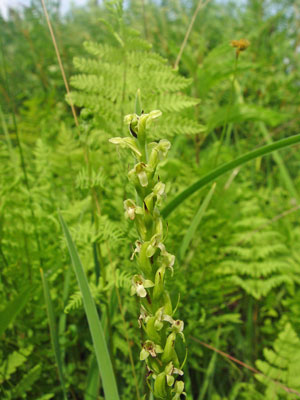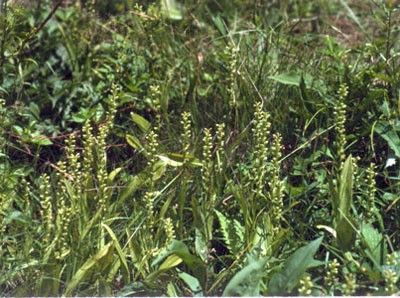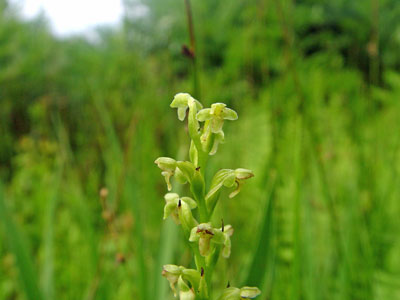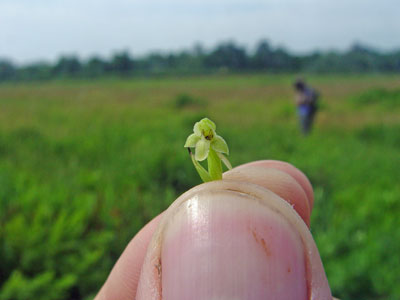DACF Home → Bureaus & Programs → Maine Natural Areas Program → Communities, Plants, and Animals → Rare Plants → Platanthera flava

Platanthera flava (L.) Lindl. var. herbiola (R. Br. in Ait. & Ait. f.) Luer
Pale Green Orchis
- State Rank: S2
- Global Rank: G4?T4Q
- State Status: Special Concern
Habitat: Swampy woods, bottomlands, swales, and wet shores. [Non-tidal rivershore (non-forested, seasonally wet); Open wetland, not coastal nor rivershore (non-forested, wetland)]

Range: Nova Scotia and New Brunswick, southern Ontario, Minnesota south to upland Virginia, Tennessee to Missouri.
Aids to Identification: Members of the genus Platanthera are known by their uniformly colored, spurred flowers. The lowermost petal, called the labellum, is highly modified in these orchids and does not resemble the other sepals and petals. Platanthera flava grows 10-60 cm high with several large, alternate leaves along the stem, terminating in a compact, slender floral raceme. The long-lasting greenish and fragrant flowers have a slender spur longer than the lip (the larger, modified, lower petal). The oblong lip curving under the flower is neither 3-lobed nor fringed but has a tubercle (a fin-like protuberance) near the center. The northern variety, herbiola, is distinguished from the southern, typical variety (which is not known to occur in Maine but does occur in Nova Scotia) by its large leaves extending up the stem and floral bracts more than twice as long as the flowers.

Ecological characteristics: The habitat in which this orchid is found is quite variable across the species's range. In some parts, it is most frequent in low wet woods where it may stand in shallow water thick with decaying leaves; in others, it may be found in dry sterile soil or salt marshes. In our area, it is most often found in the damp circumneutral soil of either ledgy river shores or alluvial woods. The tubercle on the lower lip and a matching ridge on the roof of the flower divide the entrance of the nectary into two channels which direct the small moth and mosquito pollinators under one or the other of the diverging anther-sacs.
Phenology: In Maine, flowers in July.
Family: Orchidaceae

Synonyms: Habenaria flava (L.) R. Br.;
Known Distribution in Maine: This rare plant has been documented from a total of 39 town(s) in the following county(ies): Aroostook, Cumberland, Franklin, Hancock, Kennebec, Knox, Lincoln, Oxford, Penobscot, Piscataquis, Somerset, Waldo, York.
Reason(s) for rarity: In Maine, habitat depletion.
Conservation considerations: Maintain hydrologic integrity of its rivershore habitat, including the natural disturbance by water and ice. Orchids are popular among some speciality gardeners, and populations are vulnerable to unscrupulous or uneducated collectors. Plants dug from the wild usually do not survive; moreover, removing these plants harms the natural population and may cause its eventual disappearance. This plant has not been propagated successfully, and any plants offered for sale have been dug from the wild.